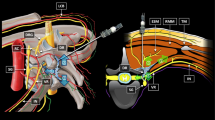Abstract
Background
The cutaneous influence areas of the different sympathetic ganglia have not been fully established to date. The aim of this study was to define the cutaneous influence area of sympathetic ganglia T2–T3.
Methods
A total of 210 patients with primary hyperhidrosis (PH) underwent 420 thoracoscopic sympathicolysis procedures of ganglia T2–T3 in a prospective study. All completed a preoperative questionnaire and a second questionnaire 12 months after the operation. The questionnaires evaluated perspiration in the different body areas. Only the zones of anhidrosis were considered in delimiting the cutaneous expression of sympathetic ganglia T2–T3.
Results
Redistribution of perspiration as reported by the patients comprised significant reduction in the palms, axillas, and soles, and an increase in the abdomen, back, and gluteal and popliteal regions. Regarding the incidence of anhidrosis by anatomical location, statistically significant changes were recorded in the head, hands, axillas, and soles (p < 0.001).
Conclusions
Bilateral upper thoracic sympathicolysis is followed by redistribution of body perspiration, with a clear decrease in the zones regulated by mental or emotional stimuli, and an increase in the areas regulated by environmental stimuli, though we are unable to establish the etiology of this redistribution.
Similar content being viewed by others
References
Albertyn J, Barry R, Odendaal CL (2004) Cluster headache and the sympathetic nerve. Headache 44: 183–185
Andrews B, Rennie J (1997) Predicting changes in the distribution of sweating following thoracoscopic sympathectomy. Br J Surg 84: 1702–1704
Chalmers TM, Keele CA (1952) The nervous and chemical control of sweating. Br J Dermatol 64: 43–54
Kao CC, Chen YL, Lin JY, Hsieh CS, Tsai JC (1996) Endoscopic sympathectomy treatment for craniofacial hyperhidrosis. Arch Surg 131: 1091–1094
Kuntz A (1927) Distribution of the sympathetic rami to the brachial plexus: its relation to sympathectomy affecting the upper extremity. Arch Surg 15: 871–877
Lin CC, Mo LR, Lee SM, Ng SM, Hwang MH (1998) Thoracoscopic T2-sympathectomy block by clipping: a better and reversible operation for treatment of hyperhidrosis palmaris. Experience in 326 cases. Eur J Surg Suppl 580:13–16
List CF, Peet MM (1938) Sweat secretion in man. II Anatomic distribution of disturbances in sweating associated with lesions of the sympathetic nervous system. Arch Neurol Psychiatry 40: 27–43
Moya J, Prat J, Morera R, Ramos R, Villalonga R, Ferrer G (2003) Dermatomas simpáticos correspondientes a los ganglios T2 y T3. Estudio prospectivo en 100 procedimientos de simpaticolisis torácica superior. Arch Bronconeumol 39(1): 19–22
Moya J, Ramos R, Morera R, Villalonga R, Perna V, Macia I, Ferrer G (2006) Results of high bilateral endoscopic thoracic sympathectomy and sympatholysis in the treatment of primary hyperhidrosis: a study of 1016 procedures. Arch Bronconeumol 42(5): 230–234
Moya J, Ramos R, Vives N, Pérez J, Morera R, Perna V, Villalonga R, Ferrer G (2004) Compensatory sweating after thoracic sympathectomy. Prospective study of 123 cases. Arch Bronconeumol 40(8): 360–363
Moya J, Ramos R, Morera R, Villalonga R, Perna V, Macia I, Ferrer G (2006) Thoracic sympathicolysis for primary hyperhidrosis. Surg Endosc 20: 598–602
Neumayer C, Panhofer P, Zacherl J, Bischof G (2005) Effect of endoscopic thoracic sympathetic block on plantar hyperhidrosis. Arch Surg 40(7): 676–680
Ramos R, Moya J, Morera R, Masuet C, Perna V, Macia I, Escobar I, Villalonga R (2006) An assessment of anxiety in patients with primary hyperhidrosis before and after endoscopic thoracic sympathicolysis. Eur J Cardiothorac Surg 30(2): 228–231
Ramsaroop L, Partab P, Singh B, Satyapal KS (2001) Thoracic origin of a sympathetic supply to the upper limb: the “nerve of Kuntz”revisited. J Anat 199: 675–682
Ray S, Hinsey J, Geohegan WA (1943) Observations on the distribution of the sympathetic nerves to the pupil and upper extrmity as determined by stimulation of the anterior roots in man. Ann Surg 118: 647–655
Riet M, Smet AA, Kuiken H, Kazemier G, Bonjer HJ (2001) Prevention of compensatory hyperhidrosis after thoracoscopic sympathectomy for hyperhidrosis. Surg Endosc 15(10): 1159–1162
Saper CB, Loewy AD, Swanson LW, Cowan WM (1976) Direct hypothalamo-autonomic connections. Brain Res 117(2): 305–312
Thomas A (1926) Les moyens d´exploration du système sympathique et leur valeur. Rev Neurol 1: 767–928
Wepf R, Gross M (1987) Role de la neurotomie sympathique thoracique haute dans le traitment de la migraine. Rev Méd Sise Romande 107: 427–431
Yoon H, Ha Y, Park YG, Chang JW (2003) Thoracoscopic limited T-3 sympathicotomy for primary hyperhidrosis: prevention for compensatory hyperhidrosis. J Neurosurg 99(suppl 1): 39–43
Author information
Authors and Affiliations
Corresponding author
Rights and permissions
About this article
Cite this article
Ramos, R., Moya, J., Macia, I. et al. Anatomical redistribution of sweating after T2–T3 thoracoscopic sympathicolysis: a study of 210 patients. Surg Endosc 21, 2030–2033 (2007). https://doi.org/10.1007/s00464-007-9262-4
Received:
Revised:
Accepted:
Published:
Issue Date:
DOI: https://doi.org/10.1007/s00464-007-9262-4




